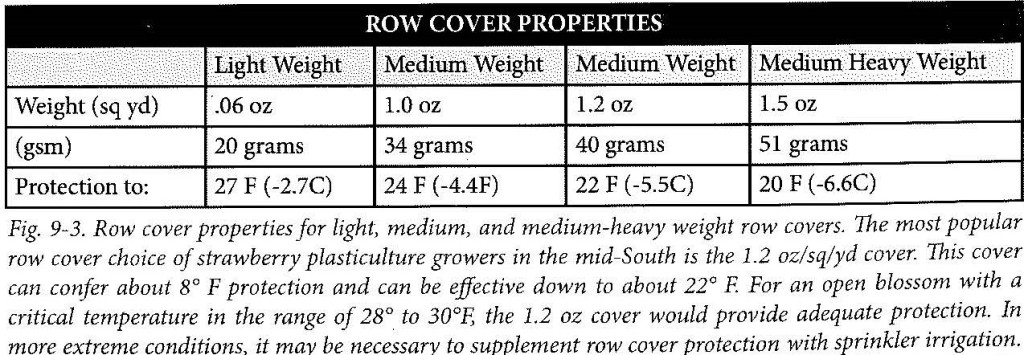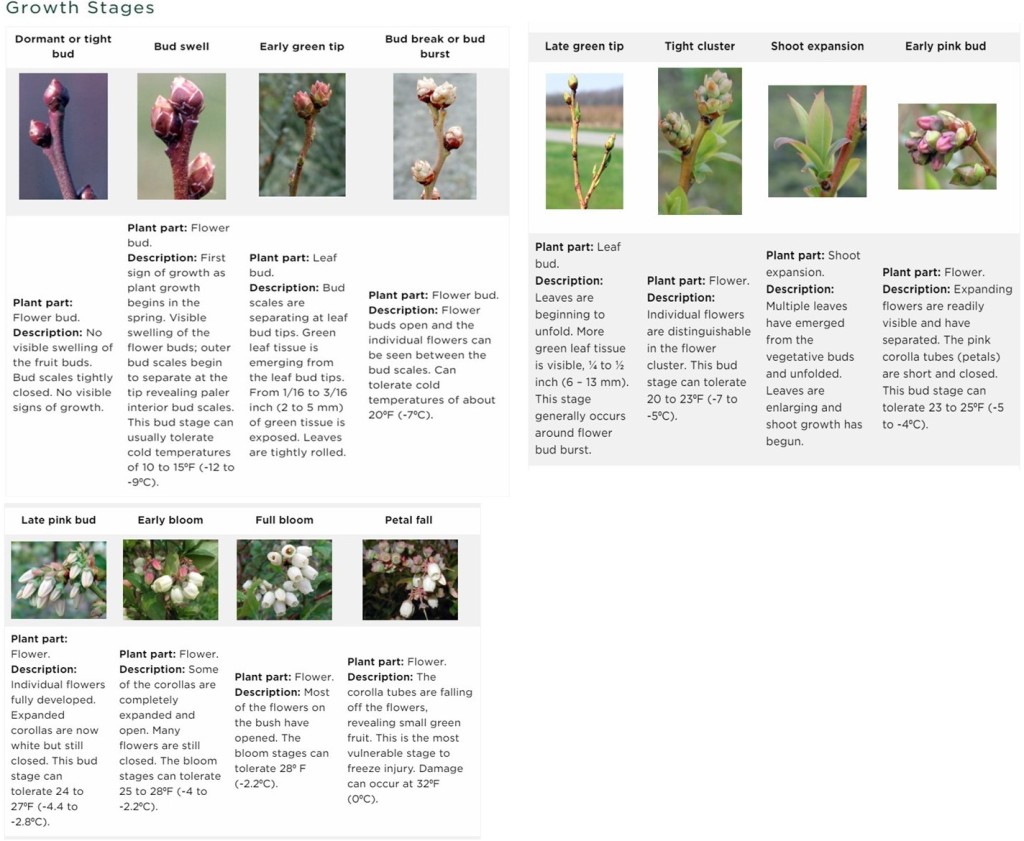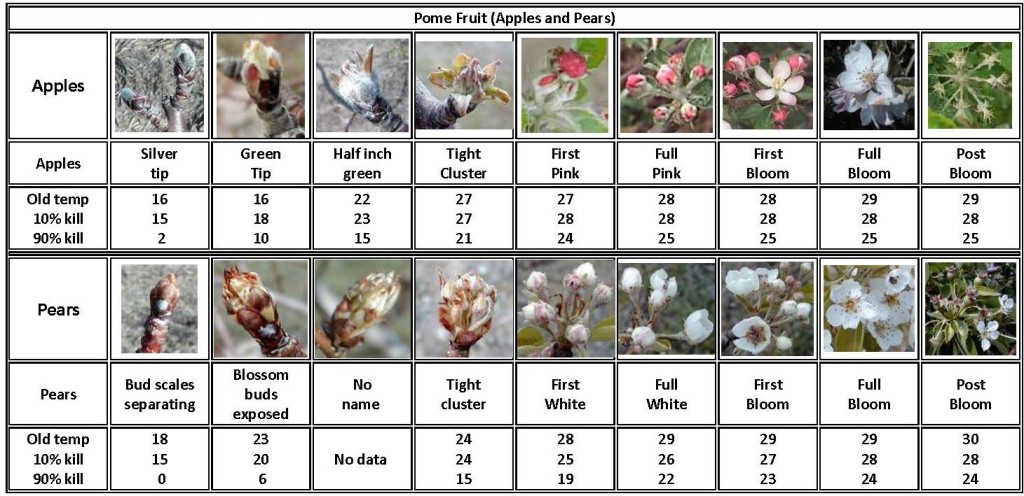Growers have been keeping a close eye on the weather this week as temperatures are forecast to reach the mid to low 20s around the state Saturday night and Sunday morning. 5 to 15 mph winds are also expected. With crops like peaches, blueberries, and strawberries now in bloom and young brassica transplants in the ground, we will likely experience damage around the state. Here are a few considerations for each crop.
Strawberries
Growers should plan to cover their strawberries to protect blooms and developing fruit. According to the chart below from the NC Strawberry Association’s Strawberry Plasticulture Guide, row covers of at least 1.2 oz thickness will protect plants down to 22 degrees.

When using row covers, it is possible that we may still see some cold injury as blooms that are in contact with the row covers can be injured (up to 5% of open blooms). It is going to be windy, so make sure to anchor row covers to the ground well. Rock bags are preferred over bricks and cinder blocks as the sharp edges can tear the row covers as the covers sway with the wind.
For folks thinking about protecting blooms with overhead sprinklers, this is not advised in this situation. Because of the potential for winds up to 15 mph, using overhead irrigation alone is likely to result in extensive damage due to evaporative cooling heat losses. In addition, if the hourly forecast holds true, irrigation would need to be run continuously for 12-14 hours (as soon as the temperature is around 36 degrees until ice begins melting the following morning) at around 0.2 inches per hour. This would require a tremendous amount of water and may contribute to root rot issues in the coming weeks. Row covers are the better option this time.
Peaches
At this point, most peach trees are somewhere between first bloom and post-bloom stage. If temperatures dip down to between 26-28 for a period of 30 minutes or more, we will suffer damage to the crop.

Peaches need about 10-15% of blooms to go undamaged in order to produce a good crop, so there is potential that one cold-weather event would still leave the possibility of decent fruit development. There is also potential that trees could develop fruit despite the cold damage, but the fruit could be of poor quality with split pits, cracks, or premature rotting. It’s a waiting game at this point and we will hope for the best.
Here are a few tips for preparing orchards for the cold:
- Grass middles, if present, should be mowed as close as possible to the soil.
- Soils should already be adequately watered from the rain. If they aren’t, irrigation would be recommended.
- Wind machines could prove useful only if wind speeds drop below 5mph (Source). May need supplemental heat source to complement (hay bales).
- Water protection systems are not recommended for this situation.
- Unpruned trees can withstand freeze event better than pruned ones.
- Be warry of freeze protection products promising the world.
- Make sure you document freeze event with your insurance agent (keep copy with pictures).
Blueberries
Should I protect my blueberries? First, at what stage are your blueberry flowers? Blueberry flowers lose cold tolerance as they mature into open flowers and fruit. See below.

Since much of the state is forecast to be around 23°F for the low on Sunday morning, without freeze protection, any blooms that are at the early pink stage or later are likely to be damaged. Blueberries can experience a significant loss of flower and early fruit and still come through with a decent crop. The remaining fruit can compensate some with increased fruit size. How much can you lose without having that much of a loss? 20-30% of the early blooms/fruit is not an unreasonable number. Rabbiteyes (at open bloom) are slightly less cold tolerant than highbush, by about 1-2°F. Get into the field and assess the stage of your blueberry plants.
So how are you going to protect the blueberries? Overhead water is the most practical. But, you can absolutely ruin a crop if not set up properly, and this is not something you can slap together in a few minutes the day before a freeze event. overhead systems need to be designed and installed well in advance. Here are some links to some resources that may help: UGA, NCSU, USDA, another NCSU.
Floating row covers are very effective on radiation freezes (where the air is still and the temperature plummets), but much less so on advection freezes (where the wind really blows). Wind and row covers are not friends at all, especially when the row covers are up off of the ground. The problem is that this weekend it is going to be an Advection Freeze. This is a problem in many ways. And honestly, the most challenging to protect the crop.
In the currently forecast conditions, it will be very difficult to successfully perform freeze protection. Row covers over blueberries are near-impossible to secure, and overhead water is difficult to maintain consistent spray patterns. And you do need to maintain consistent spray patterns and water flow until thawing occurs the following morning. If you plan to overhead water, DO NOT turn off the water prior to thaw. You can quickly undo all of your efforts from the prior night. Also, if you are planning to overhead water, allow for evaporative cooling. That is the cooling effect that occurs when you first turn on the water. If you turn on the water at 33°F, you will instantly flash freeze the area you are trying to protect. On a night with extremely low dew points, allow 5-6°F for evaporative cooling. So, turn the water on at or just above 37°F. If you plan to turn the water on you must be dedicated to it until the next day. Turning off the water or not maintaining the sprinkler heads (allowing them to freeze up) throughout the night can cause more damage than not protecting at all.
Apples/Pears
Apple and pear growers in the upstate report having trees in the “tight cluster” stage. With temperatures forecast to reach 20 degrees in parts of Oconee county, there is the potential for growers to experience severe cold damage.

Greens
Expect to see damage to tender greens (mustard and turnip) if the temperatures dip below 25 for more than a couple hours, which it is forecast to do.
Overwintered collards and kale will likely make it through the cold. Recently transplanted collards, kale, broccoli, and cabbage may be more sensitive, especially given the unseasonably warm growing conditions they’ve experienced thus far. Covering may offer some protection, but any tissue in contact with the row covers is still at risk of cold injury.
Credits:
- Strawberries – Justin Ballew, Rob Last, and Zack Snipes
- Peaches – Andy Rollins and Sarah Scott
- Blueberries – Bruce McLean
- Apples/ Pears – Kerrie Roach
- Greens – Justin Ballew and Zack Snipes
2 responses to “Hard Freeze Forecast for the Weekend”
[…] The National Weather Service has noted that those of us in Georgia, northern Florida, southern Alabama, and the Carolinas can expect some wild weather in the next few days. On Friday, March 12, warm and moist air ahead of an approaching front will bring a widespread threat of severe weather to SE Alabama, southern GA, and northern FL. Folks in those areas should be keeping an eye on the weather since the likelihood of tornado watches and some strong wind and heavy rain are likely. If you are in the eastern part of that region, including coastal GA and points up the coast, you could see that last into Saturday. Behind the front, much colder air will flow into the area, bringing low wind chills and the chance of some snow in far northern AL and GA. As the cold air settles in, widespread killing frost is expected to affect a lot of the region on Sunday morning. That could kill off blooming peaches as well as some blueberries, strawberries, and other vulnerable crops that have been running earlier than usual after our warm winter. I am sure that producers are watching this with concern after last year’s late April frost that caused big losses for some farmers. The maps below are just for the NWS Peachtree City office coverage area, so if you are in one of the other states, make sure you get the latest forecasts from your own NWS office. You can also read more from the South Carolina Grower’s blog at https://scgrower.com/2022/03/10/hard-freeze-forecast-for-the-weekend/. […]
LikeLike
[…] as some crops are right now, I’d rather play it safe. For folks growing other fruit crops, take a look at this post from last March for some info on what we can expect based on the growth stages of your crops. If you experience […]
LikeLike